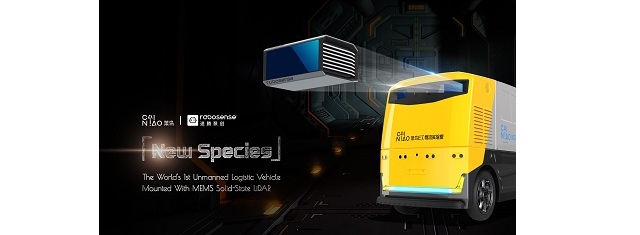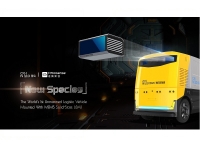Automobiles
ALIBABA GROUP s CAINIAO NETWORK And ROBOSENSE Jointly Released -G PLUS -
G PLUS Driverless Delivery Vehicle

Alibaba´s Cainiao G Plus (Source: RoboSense)
USPA NEWS -
Alibaba Group's Cainiao Network and RoboSense jointly released on May 31, G Plus, the World's First Solid-State LiDAR Unmanned Logistics Vehicle. Announced at Alibaba's Cainiao Network 2018 Global Smart Logistics Summit, the G Plus Driverless Delivery Vehicle provides Solid-State LiDAR Technology, RS-LiDAR-M1Pre, developed by China's RoboSense. This is the First Time that Solid-State LiDAR has been used in the Development of an Unmanned Vehicle.
Alibaba Group's Cainiao Network and RoboSense jointly released on May 31, G Plus, the World's First Solid-State LiDAR Unmanned Logistics Vehicle. Announced at Alibaba's Cainiao Network 2018 Global Smart Logistics Summit, the G Plus Driverless Delivery Vehicle provides Solid-State LiDAR Technology, RS-LiDAR-M1Pre, developed by China's RoboSense. This is the First Time that Solid-State LiDAR has been used in the Development of an Unmanned Vehicle.
RoboSense and Alibaba will provide Delivery Vehicles with Solid-State LiDARs for G Plus Unmanned Logistics Cars/Trucks, drastically reducing Cost. The Vehicles can be Mass-Produced, allowing Rapid Expansion of Unmanned Logistics Vehicles and streamlining Mass Market Logistics. Unmanned Cars and Trucks can be equipped with Smart Devices, for a Courier Vehicle, Mobile Self-Pickup Station, Mobile Coffee Vending Cart, etc., for New Retail Scenarios.
Alibaba's Cainiao G Plus is equipped with Three RS-LiDAR-M1Pres, Two in Front and One in Rear, to ensure the Most Powerful 3D Perception for driving. This allows Vehicles to clearly see the Direction of Travel : Shape, Distance, Azimuth, Travel Speed, and Direction of Travel of Pedestrians, Cars, Trucks, etc., as well as Exact Areas to drive, ensuring Smooth Flow of Unmanned Logistics Vehicles in Complex Road Environments.
Alibaba's Cainiao G Plus is equipped with Three RS-LiDAR-M1Pres, Two in Front and One in Rear, to ensure the Most Powerful 3D Perception for driving. This allows Vehicles to clearly see the Direction of Travel : Shape, Distance, Azimuth, Travel Speed, and Direction of Travel of Pedestrians, Cars, Trucks, etc., as well as Exact Areas to drive, ensuring Smooth Flow of Unmanned Logistics Vehicles in Complex Road Environments.
RS-LiDAR-M1Pre is the first MEMS Solid-State LiDAR launched by RoboSense. Presented at CES 2018, the Core Technology of the MEMS LiDAR is disruptive to Traditional Mechanical Multi-Beam Radars. RS-LiDAR-M1Pre MEMS Micro Mirror Scanning Scheme requires only a Few Laser Emitters and Receivers to scan the MEMS Micro-Mirror in Both Directions because of the Swing Angle. Resolution is a Very Fine, High and Vertical Angle Resolution of 0.2° throughout Angle of View.
For Traditional Mechanical Multi-Beam LiDAR to achieve the Same Effect, they require more than a Hundred Laser Transmitters and Receivers to simultaneously rotate and scan, greatly increasing Costs and reducing Yield and Reliability, making the Advantages of MEMS Solid-State LiDAR Technology Obvious. While improving the Performance of LiDAR, Cost Savings is great, and Miniaturization greatly improves Stability.
Source : RoboSense
Ruby BIRD
http://www.portfolio.uspa24.com/
Yasmina BEDDOU
http://www.yasmina-beddou.uspa24.com/
For Traditional Mechanical Multi-Beam LiDAR to achieve the Same Effect, they require more than a Hundred Laser Transmitters and Receivers to simultaneously rotate and scan, greatly increasing Costs and reducing Yield and Reliability, making the Advantages of MEMS Solid-State LiDAR Technology Obvious. While improving the Performance of LiDAR, Cost Savings is great, and Miniaturization greatly improves Stability.
Source : RoboSense
Ruby BIRD
http://www.portfolio.uspa24.com/
Yasmina BEDDOU
http://www.yasmina-beddou.uspa24.com/
Ruby Bird Yasmina Beddou Hangzhou G Plus Alibaba Group S Cainiao Network Robosense First Solid-state Lidar Unmanned Logistics Vehicle Driverless Delivery Vehicle
Liability for this article lies with the author, who also holds the copyright. Editorial content from USPA may be quoted on other websites as long as the quote comprises no more than 5% of the entire text, is marked as such and the source is named (via hyperlink).






